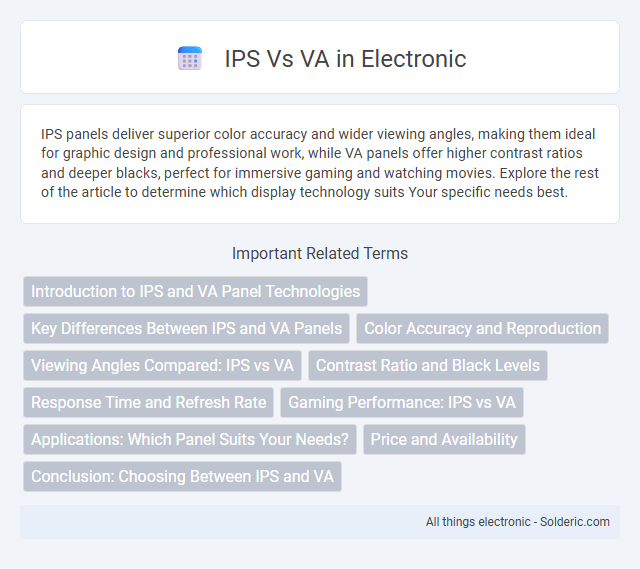IPS panels deliver superior color accuracy and wider viewing angles, making them ideal for graphic design and professional work, while VA panels offer higher contrast ratios and deeper blacks, perfect for immersive gaming and watching movies. Explore the rest of the article to determine which display technology suits Your specific needs best.
Comparison Table
| Feature | IPS (In-Plane Switching) | VA (Vertical Alignment) |
|---|---|---|
| Viewing Angles | Wide, up to 178deg horizontal and vertical | Narrower than IPS, typically up to 160deg |
| Color Accuracy | Highly accurate and consistent colors | Good, but less accurate than IPS |
| Contrast Ratio | Typically 1000:1 | Higher contrast, often 3000:1 or more |
| Response Time | Faster, around 4-8 ms | Slower, around 8-12 ms |
| Black Levels | Moderate black levels | Deeper blacks and better dark scenes |
| Better For | Color-critical work, gaming, general use | Watching movies, darker environments |
Introduction to IPS and VA Panel Technologies
IPS panel technology offers superior color accuracy and wide viewing angles, making it ideal for tasks requiring precise color reproduction. VA panels provide higher contrast ratios and deeper blacks, enhancing image depth and overall visual experience in dark environments. Your choice between IPS and VA depends on whether you prioritize color fidelity or contrast performance.
Key Differences Between IPS and VA Panels
IPS panels deliver superior color accuracy and wider viewing angles, making them ideal for graphic design and professional applications. VA panels offer higher contrast ratios and deeper blacks, enhancing the visual experience in dark scenes and gaming environments. Response times are generally faster on IPS panels, while VA panels excel in providing better overall luminance uniformity.
Color Accuracy and Reproduction
IPS panels offer superior color accuracy and wide color gamut reproduction, making them ideal for tasks requiring precise color representation such as photo editing and graphic design. VA panels typically provide higher contrast ratios but can fall short in consistent color accuracy and uniformity, leading to less vibrant and slightly distorted colors in certain viewing angles. Choosing an IPS display ensures your visuals maintain true-to-life colors across varying lighting conditions and screen positions.
Viewing Angles Compared: IPS vs VA
IPS panels provide superior viewing angles, maintaining consistent color accuracy and brightness up to 178 degrees, which ensures minimal distortion when viewed from the side. VA panels typically have narrower viewing angles, around 160 degrees, often resulting in color shifting and reduced brightness at wider angles. If your setup involves multiple viewers or you frequently view the screen off-center, IPS technology better preserves image quality across varied positions.
Contrast Ratio and Black Levels
VA panels offer superior contrast ratios, often exceeding 3000:1, resulting in deeper black levels and enhanced image depth compared to IPS panels, which typically have contrast ratios around 1000:1. The higher contrast ratio in VA technology makes it ideal for dark room viewing and content with high shadow detail. IPS panels, while providing better color accuracy and viewing angles, tend to display grayer blacks due to their lower contrast performance.
Response Time and Refresh Rate
IPS panels generally have slower response times compared to VA panels, resulting in slightly more motion blur during fast-paced scenes or gaming. VA panels typically offer faster response times, improving clarity and reducing ghosting effects in dynamic visuals. Your choice between IPS and VA should consider whether you prioritize vibrant colors and wide viewing angles or a higher refresh rate with quicker pixel transitions for smoother motion.
Gaming Performance: IPS vs VA
IPS panels offer faster response times and better motion clarity essential for competitive gaming, while VA panels provide superior contrast ratios and deeper blacks that enhance immersion in visually rich games. The higher refresh rates and lower input lag of IPS displays contribute to smoother gameplay experiences, making them preferred for fast-paced gaming scenarios. VA panels, though slower in response, excel in delivering vibrant image depth, which benefits gamers who prioritize visual quality over reaction speed.
Applications: Which Panel Suits Your Needs?
IPS panels excel in applications requiring accurate color reproduction and wide viewing angles, making them ideal for graphic design, photo editing, and professional video work. VA panels offer superior contrast ratios and deeper blacks, which are well-suited for gaming, watching movies, and general multimedia consumption. Choosing between IPS and VA depends on prioritizing color accuracy and viewing angles versus contrast and black depth for specific use cases.
Price and Availability
IPS panels generally come at a higher price point compared to VA panels due to their superior color accuracy and wider viewing angles, making them a preferred choice for professional use. VA panels are more budget-friendly and widely available in mainstream monitors, offering better contrast ratios but limited viewing angles. Buyers seeking affordable options with deep blacks often find VA displays more accessible, while those prioritizing color precision may invest more in IPS technology.
Conclusion: Choosing Between IPS and VA
Choosing between IPS and VA panels depends on your priorities: IPS offers superior color accuracy and wider viewing angles ideal for graphic work and media consumption, while VA excels in contrast ratios and deeper blacks, perfect for gaming and dark-room environments. Your decision should consider the environment where the monitor will be used and the importance of color fidelity versus contrast performance. Balancing these factors ensures you select the display technology that best enhances your visual experience.
IPS vs VA Infographic

 solderic.com
solderic.com